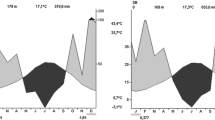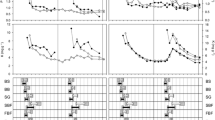Abstract
In trees, reproduction constitutes an important resource investment which may compete with growth for resources. However, detailed analyses on how growth and fruit production interact at the shoot level are scarce. Primary canopy growth depends on the development of current-year shoots and their secondary growth might also influence the number and size of fruits supported by them. We hypothesise that an enhanced thickening of current-year shoots is linked positively to acorn production in oaks. We analysed the effect of acorn production on shoot growth of two co-occurring Mediterranean oak species with contrasting leaf habit (Quercus ilex, Quercus faginea). Length and cross-sectional area of current-year shoots, apical bud mass, number of leaves and acorns, xylem and conductive area, number of vessels of acorn-bearing and non-bearing shoots were measured in summer and autumn. Nitrogen and carbohydrates analyses were also performed in stems and leaves of both shoot types. Stem cross-sectional area increased in acorn-bearing shoots when compared with non-bearing shoots for both species and such surplus secondary growth was observed since summer. In bearing shoots, the total transversal area occupied by vessels decreased significantly from basal to apical positions along the stem as did the xylem area and the number of vessels. Leaves of bearing shoots showed lower nitrogen concentration than those of non-bearing shoots. Carbohydrate concentrations did not differ in stems and leaves as a function of the presence of acorns. Such results suggest that carbohydrates may preferentially be allocated towards reproductive shoots, possibly through enhanced secondary growth, satisfying all their carbon demands for growth and reproduction. Our findings indicate that acorn production in the two studied oaks depends on shoot secondary growth.




Similar content being viewed by others
References
Al Afas N, Pellis A, Niinemets U, Ceulemans R (2005) Growth and production of a short rotation coppice culture of poplar. II. Clonal and year-to-year differences in leaf and petiole characteristics and stand leaf area index. Biomass Bioenerg 28:536–547. doi:10.1016/j.biombioe.2004.11.010
Alla AQ, Camarero JJ, Rivera P, Montserrat-Martí G (2011) Variant allometric scaling relationships between bud size and secondary shoot growth in Quercus faginea: implications for the climatic modulation of canopy growth. Ann For Sci 68:1245–1254. doi:10.1007/s13595-011-0093-z
Amaral Franco J (1990) Quercus. In: Castroviejo S, Laínz M, López González G, Montserrat P, Muñoz Garmendia F, Paiva J, Villa L (eds) Flora Ibérica. Real Jardín Botánico, C S I C, pp 15–36
Aschan G, Pfanz H (2003) Non-foliar photosynthesis—a strategy of additional carbon acquisition. Flora 198:81–97. doi:78/0367-2530-00080
Barnola P, Crabbé J (1993) L’activite cambiale, composante active ou passive dans les reactions de croissance de l’arbre? Acta Botanica Gallica 140:403–412
Buysse J, Merckx R (1993) An improved colorimetric method to quantify sugar content of plant tissue. J Exp Bot 44:1627–1629. doi:10.1093/jxb/44.10.1627
Camarero JJ, Albuixech J, López-Lozano R, Casterad MA, Montserrat-Martí G (2010) An increase in canopy cover leads to masting in Quercus ilex. Trees 24:909–918. doi:10.1007/s00468-010-0462-5
Campelo F, Gutiérrez E, Ribas M, Nabais C, Freitas H (2007) Relationships between climate and double rings in Quercus ilex from northeast Spain. Can J For Res 37:1915–1923. doi:10.1139/X07-050
Cochard H, Coste S, Chanson B, Guehl JM, Nicolini E (2005) Hydraulic architecture correlates with bud organogenesis and primary shoot growth in beech (Fagus sylvatica). Tree Physiol 25:1545–1552. doi:10.1093/treephys/25.12.1545
Corcuera L, Camarero JJ, Gil-Pelegrin E (2004) Effects of a severe drought on growth and wood anatomical properties of Quercus faginea. IAWA J 25:185–204
Cremer KW (1992) Relations between reproductive growth and vegetative growth of Pinus radiata. For Ecol Manag 52:179–199
Dubois M, Gilles KA, Hamilton JK, Rebers PA, Smith F (1956) Colorimetric method for determination of sugars and related substances. Anal Chem 28:350–356. doi:10.1021/ac60111a017
FAO (1998) World reference base for soil resources. ISRIC and ISSS, Rome
Farina V, Lo Bianco R, Inglese P (2006) Shoot growth, crop load, and fruit quality within vase-shaped canopies of “Fairtime” peach trees. Eur J Hortic Sci 71:227–230
Forshey CG, Elfving DC (1989) The relationship between vegetative growth and fruiting in apple trees. Hortic Rev 11:229–287
Fujii JA, Kennedy RA (1985) Seasonal changes in the photosynthetic rate in apple trees: a comparison between fruiting and non-fruiting trees. Plant Physiol 78:519–524
George AP, Nissen RJ, Collins RJ, Rasmussen TS (1996) Effects of shoot variables and canopy position on fruit set, fruit quality and starch reserves of persimmon (Diospyros kaki L) in subtropical Australia. J Hortic Sci 71:217–226
Graves WC (1980) Annual oak mast yields from visual estimates. In: Plumb TR (ed) Symposium on the ecology, management, and utilization of California oaks. USDA Forest Service, Claremont, pp 270–274
Gross HL (1972) Crown deterioration and reduced growth associated with excessive seed production by birch. Can J Bot 50:2431–2437. doi:10.1139/b72-312
Hallé F, Oldeman RAA, Tomlinson PB (1978) Tropical trees and forests: an architectural analysis. Springer, New York
Han Q, Kabeya D, Iio A, Kakubari Y (2008) Masting in Fagus crenata and its influence on the nitrogen content and dry mass of winter buds. Tree Physiol 28:1269–1276
Han Q, Kabeya D, Hoch G (2011) Leaf traits, shoot growth and seed production in mature Fagus sylvatica trees after 8 years of CO2 enrichment. Ann Bot 107:1405–1411
Hasegawa S, Koba K, Tayasu I, Takeda H, Haga H (2003) Carbon autonomy of reproductive shoots of Siberian alder (Alnus hirsuta var. sibirica). J Plant Res 116:183–188. doi:10.1007/s10265-003-0085-7
Hirayama D, Nanami S, Itoh A, Yamakura T (2007) Individual resource allocation to vegetative growth and reproduction in subgenus Cyclobalanopsis (Quercus, Fagaceae) trees. Ecol Res 23:451–458. doi:10.1007/s11284-007-0398-4
Hoch G (2005) Fruit-bearing branchlets are carbon autonomous in mature broad-leaved temperate forest trees. Plant Cell Environ 28:651–659. doi:10.1111/j.1365-3040.2004.01311.x
Hoch G, Keel SG (2006) 13C labelling reveals different contributions of photoassimilates from infructescences for fruiting in two temperate forest tree species. Plant Biol 8:606–614. doi:10.1055/s-2006-924279
Ichie T, Kenzo T, Kitahashi Y, Koike T, Nakashizuka T (2005) How does Dryobalanops aromatica supply carbohydrate resources for reproduction in a masting year? Trees 19:704–711. doi:10.1007/s00468-005-0434-3
Johnson RS, Lakso AN (1986) Carbon balance model of a growing apple shoot. I: development of the model. J Am Soc Hortic Sci 111:160–164
Kawamura K, Takeda H (2006) Cost and probability of flowering at the shoot level in relation to variability in shoot size within the crown of Vaccinium hirtum (Ericaceae). New Phytol 171:69–80. doi:10.1111/j.1469-8137.2006.01737.x
Keel SG, Schädel C (2010) Expanding leaves of mature deciduous forest trees rapidly become autotrophic. Tree Physiol 30:1253–1259. doi:10.1093/treephys/tpq071
Knops JMH, Koenig WD, Carmen WJ (2007) Negative correlation does not imply a trade-off between growth and reproduction in California oaks. Proc Natl Acad Sci USA 104:16982–16985
Koenig WD, Knops JMH (1998) Scale of mast-seeding and tree-ring growth. Nature 396:225–226. doi:10.1038/24293
Kozlowski TT (1971) Growth and development of trees. Academic Press, New York
Landhäusser SM (2010) Aspen shoots are carbon autonomous during bud break. Trees 25:531–536. doi:10.1007/s00468-010-0532-8
Lauri PÉ, Térouanne É, Lespinasse JM (1996) Quantitative analysis of relationships between inflorescence size, bearing-axis size and fruit-set: an apple tree case study. Ann Bot 77:277–286. doi:10.1006/anbo.1996.0031
Lauri PÉ, Kelner JJ, Trottier C, Costes E (2010) Insights into secondary growth in perennial plants: its unequal spatial and temporal dynamics in the apple (Malus domestica) is driven by architectural position and fruit load. Ann Bot 105:607–616
Littell RC, Milliken GA, Stroup WW, Wolfinger RD, Schabenberger O (2006) SAS for mixed models. SAS Publishing, Cary
Miyazaki Y, Hiura T, Kato E, Funada R (2002) Allocation of resources to reproduction in Styrax obassia in a masting year. Ann Bot 89:767–772. doi:10.1093/aob/mcf107
Miyazaki Y, Hiura T, Funada R (2007) Allocation of photo-assimilated 13C from reproductive and non-reproductive shoots to fruits in Styrax obassia. Plant Species Biol 22:53–57
Monks A, Kelly D (2006) Testing the resource-matching hypothesis in the mast seeding tree Nothofagus truncata (Fagaceae). Austral Ecol 31:366–375
Montserrat-Martí G, Camarero JJ, Palacio S, Pérez-Rontomé C, Milla R, Albuixech J, Maestro M (2009) Summer-drought constrains the phenology and growth of two coexisting Mediterranean oaks with contrasting leaf habit: implications for their persistence and reproduction. Trees 23:787–799. doi:10.1007/s00468-009-0320-5
Obeso JR (1997) Costs of reproduction in Ilex aquifolium: effects at tree, branch and leaf levels. J Ecol 85:159–166. doi:10.2307/2960648
Obeso JR (2002) The costs of reproduction in plants. New Phytol 155:321–348
Obeso JR (2004) A hierarchical perspective in allocation to reproduction from whole plant to fruit and seed level. Perspective Plant Ecol Evol Syst 6:217–225. doi:10.1078/1433-8319-00080
Palacio S, Maestro M, Montserrat-Marti G (2007) Seasonal dynamics of non-structural carbohydrates in two species of Mediterranean sub-shrubs with different leaf phenology. Environ Exp Bot 59:34–42
Porter GW, Sherman WB, Beckman TG, Krewer GW (2002) Fruit weight and shoot diameter relationship in early ripening peaches. J Am Pomol Soc 56(1):30–33
Rasband WS, Ferreira T (2011) ImageJ. NIH, Bethesda
Roff DA (1992) Cost of reproduction. In: The evolution of life histories: theory and analysis. Chapman and Hall, New York, pp 145–178
Rufat J, DeJong TM (2001) Estimating seasonal nitrogen dynamics in peach trees in response to nitrogen availability. Tree Physiol 21:1133–1140. doi:10.1093/treephys/21.15.1133
Sánchez-Humanes B, Sork VL, Espelta JM (2010) Trade-offs between vegetative growth and acorn production in Quercus lobata during a mast year: the relevance of crop size and hierarchical level within the canopy. Oecologia 166:101–110. doi:10.1007/s00442-010-1819-6
Singh SP, Rawat YS, Rana BS, Negi GCS (1990) Effects of unusually large seed crop on litterfall and nitrogen retranslocation in Himalayan oaks. For Ecol Manag 32:79–86. doi:16/0378-1127(90)90162-5
Sokal RR, Rohlf FJ (1995) Biometry: the principles and practices of statistics in biological research. W H Freeman, New York
Solar A, Solar M, Štampar F (2006) Stability of the annual shoot diameter in Persian walnut: a case study of different morphotypes and years. Trees 20:449–459. doi:10.1007/s00468-006-0060-8
Sperry JS, Hacke UG, Pittermann J (2006) Size and function in conifer tracheids and angiosperm vessels. Am J Bot 93:1490–1500
Suzuki A (2000) Patterns of vegetative growth and reproduction in relation to branch orders: the plant as a spatially structured population. Trees 14:329–333. doi:10.1007/s004680050226
Tuomi J, Hakala T, Haukioja E (1983) Alternative concepts of reproductive effort, costs of reproduction, and selection in life-history evolution. Am Zool 23:25–34. doi:10.1093/icb/23.1.25
Urban L, Lu P, Thibaud R (2004) Inhibitory effect of flowering and early fruit growth on leaf photosynthesis in mango. Tree Physiol 24:387–399. doi:10.1093/treephys/24.4.387
Villar-Salvador P, Castro-Díez P, Pérez-Rontomé C, Montserrat-Martí G (1997) Stem xylem features in three Quercus (Fagaceae) species along a climatic gradient in NE Spain. Trees 12:90–96. doi:10.1007/PL00009701
Watson MA (1986) Integrated physiological units in plants. Trends Ecol Evol 1:119–123. doi:10.1016/0169-5347(86)90005-4
Watson MA, Casper BB (1984) Morphogenetic constraints on patterns of carbon distribution in plants. Ann Rev Ecol Syst 15:233–258. doi:10.1146/annurev.es.15.110184.001313
Acknowledgments
A.Q.A. and J.J.C. acknowledge the support of MAEC-AECID and ARAID, respectively. This work was supported by the Spanish Ministerio de Ciencia e Innovación and FEDER (grant numbers CGL2007-66066-C04-02/BOS, CGL2008-04847-C02-01, RTA2005-00100-CO2-00, SUM2006-00025-00-00). We thank the collaborative support within the Globimed network. We acknowledge Sara Palacio for revising a previous version of this work. We thank Elena Lahoz for performing the chemical analyses and Pedro Sánchez Navarrete for his help in field sampling.
Author information
Authors and Affiliations
Corresponding author
Additional information
Communicated by T. Grams.
Rights and permissions
About this article
Cite this article
Alla, A.Q., Camarero, J.J., Maestro-Martínez, M. et al. Acorn production is linked to secondary growth but not to declining carbohydrate concentrations in current-year shoots of two oak species. Trees 26, 841–850 (2012). https://doi.org/10.1007/s00468-011-0658-3
Received:
Revised:
Accepted:
Published:
Issue Date:
DOI: https://doi.org/10.1007/s00468-011-0658-3




